What is a Changing Places Toilet?
Since 2006, the Changing Places campaign has been raising awareness of the difficulties people with profound and complex disabilities have accessing personal care facilities whilst out in public.
Their end goal? To see a Changing Places toilet installed in every large public place.
To support this campaign, we have been installing Changing Places since 2010, fitting over 250 internal and modular facilities.
There are now over 2,300 registered Changings Places in the UK. Back in 2010, the number of registered facilities had barely passed the 250 mark! During this time, we’ve also written a lot about why Changing Places are important and how specifiers should comply with building regulations.
But there’s still a long way to go before Changing Places are commonplace enough for disabled people to go out freely, without worrying they won’t be able to find a toilet. There’s also still a lot of misconceptions around how a Changing Places toilet differs from a standard accessible toilet.
In this guide, we cover what is a Changing Places toilet, why they matter, and how they offer more than a disabled access toilet.
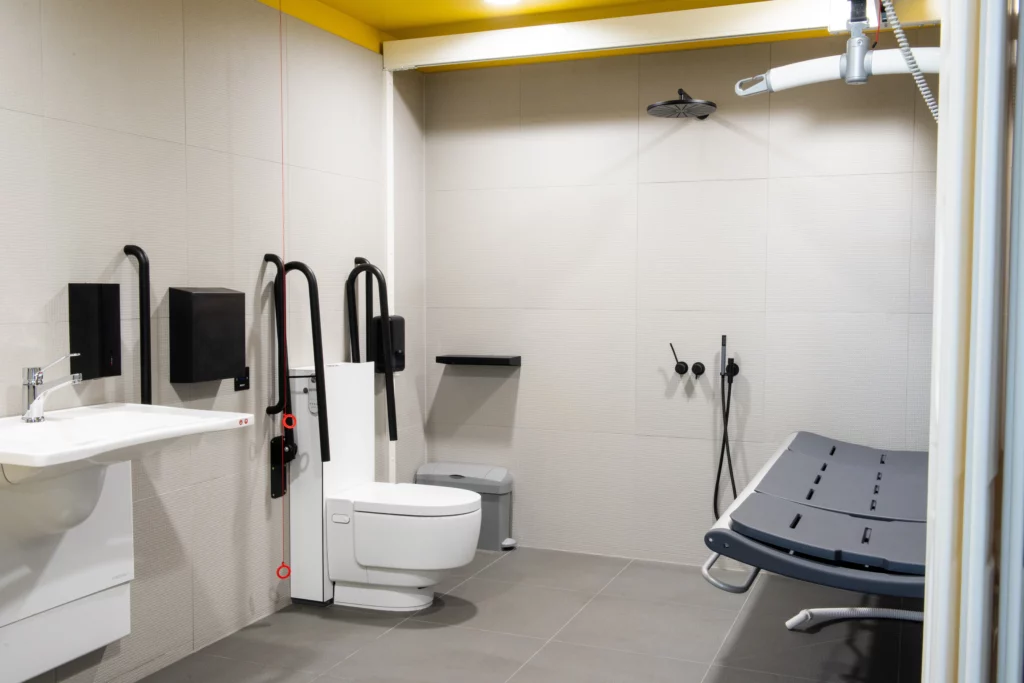
Changing Places toilet at City Hall
Standards for disabled access toilets
The Equality Act 2010 was put in place to protect people from discrimination. It legally requires public facilities to provide equal access to toilets for customers or visitors with a disability.
Disabled access toilets should meet the following standards:
- Doorways must be at least 900mm wide to allow for easy wheelchair access.
- The door must open outwards, so it doesn’t impede wheelchair users from exiting the cubicle.
- There must be at least 1500mm x 2200mm floor space so there’s enough room for a wheelchair user to turn around.
- Basins should have lever taps or automatic sensors so they can be operated by people with reduced dexterity.
- Grab rails should be positioned at appropriate heights and locations around the cubicle to offer stability when using the toilet and basin.
This is not a full list of the recommendations the government makes for accessible toilets. However, it gives you a good idea of the design considerations public places are expected to make when installing toilets.
Changing Places toilets
There is a common misconception that disabled toilets adequately meet all care needs. This is simply not the case.
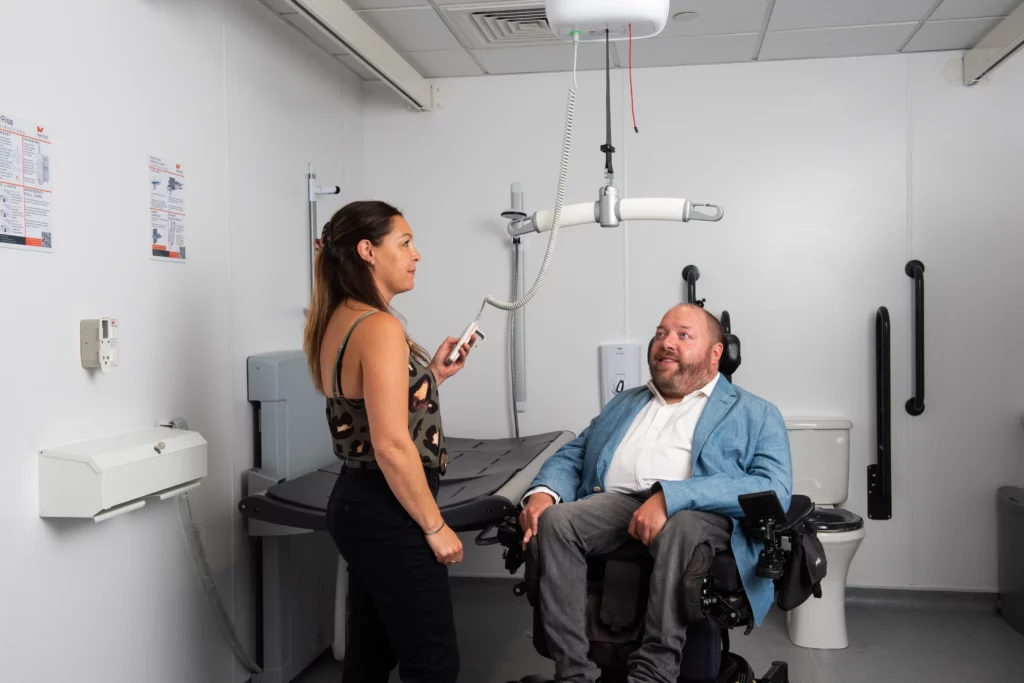
Changing Places provide the space and equipment to enable those with complex needs to use the toilet safely, in comfort and with dignity.
More than 250,000 people in the UK require much larger care spaces, with toilets that are equipped with specialist healthcare equipment to allow them to use the toilet in safety, comfort and with dignity.
Changing Places toilets meet that requirement.
Much larger (12m2) than your standard accessible loo, Changing Places provide the right amount of space for an individual to be supported by a family member or carer. They also include a range of specified equipment including an overhead hoist system, changing bench, height-adjustable wash basin and privacy screen.
Since 2021, most new public buildings are now legally required to have a Changing Places toilet, meeting a set number of rules and regulations under the British Standard ‘BS8300:2018‘.
To help you meet the latest guidelines, take a look at our blog on ‘Changing Places Equipment – What does it need to include‘.
Modular Changing Places toilets
Not every building or venue has the ability to house an internal Changing Places toilet.
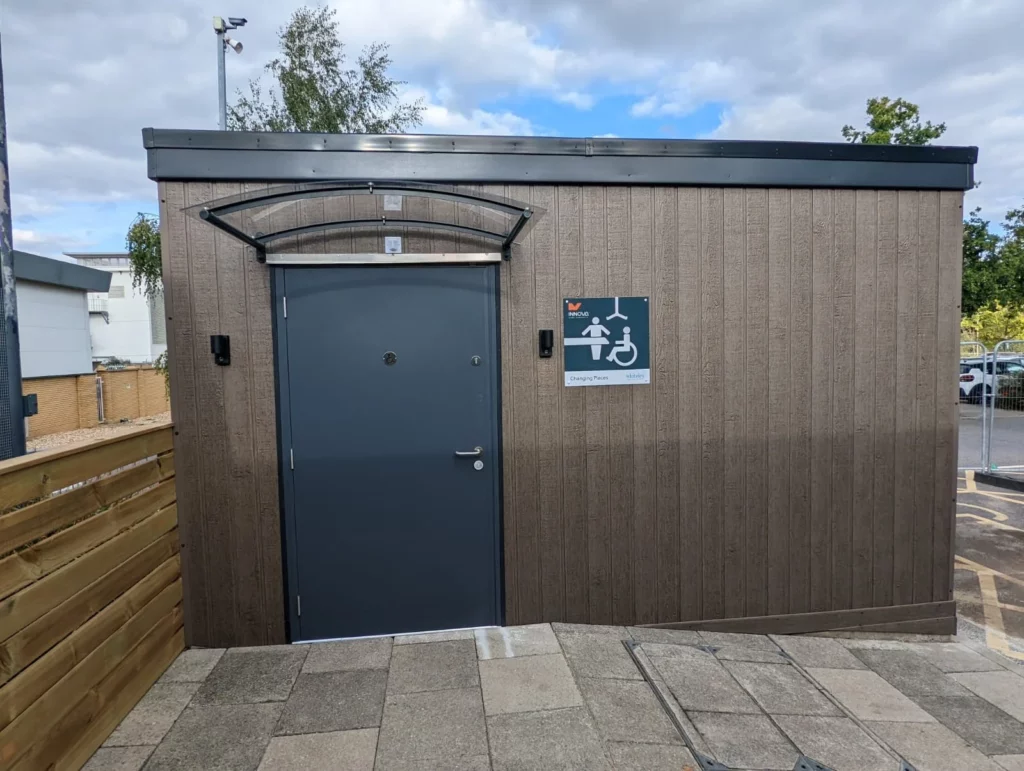
Modular Changing Places toilet installed at Whiteley Shopping Centre.
However, that doesn’t mean they can’t include accessible toilets.
Modular Changing Places provide a fantastic alternative for places like parks, beaches and listed buildings who don’t have the infrastructure, space or permissions to install an internal facility.
Built fully off-site, modular Changing Places are pre-fabricated units that can be situated outside to provide accessible toilet facilities.
Installed in half a day onto a prepared base with services already in place, these external units deliver a quick and effective way of including a compliant Changing Places.
Take a look at how modular Changing Places enhance accessibility by reading our case study with the Royal Edinburgh Military Tattoo.
How are Changing Places different from standard accessible toilets?
Looking at some of the standards set for disabled access toilets, you might have noticed that many of the recommendations focus on making public toilets wheelchair accessible. This is important — NHS England estimates that there are around 1.2 million wheelchair users in the UK.
However, these standards neglect the needs of individuals with multiple, complex or profound disabilities beyond being wheelchair users.
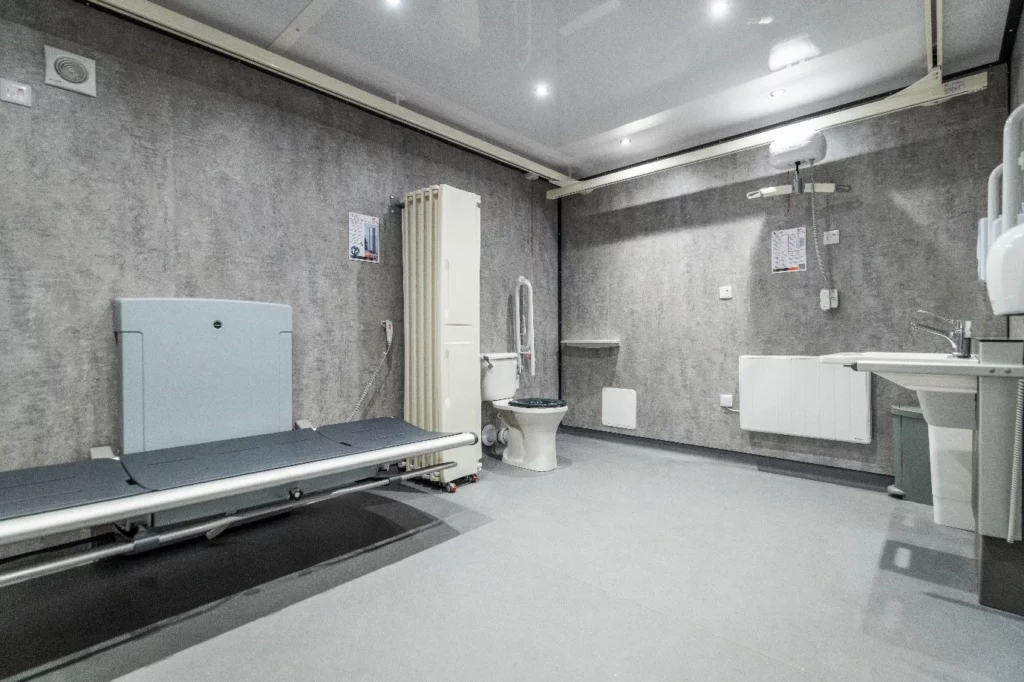
Inside the modular Changing Places toilet at the Royal Edinburgh Military Tattoo.
There are over 250,000 people in the UK with brain injuries, Motor Neurone Disease, dementia, cerebral palsy and other conditions that mean they need personal assistance to use the toilet or change continence pads. Standard accessible toilets simply do not have the facilities to make this possible.
To put it bluntly, Changing Places are more hygienic, safer, better-equipped, with enough space for disabled individuals and their carer(s) to use them with dignity and safety.
Changing Places aim to be usable for people with a wide range of disabilities rather than just being accessible for wheelchair users.
Changing Places vs. Accessible Toilets — Comparison
This comparison table shows the differences between the facilities typically included in an accessible toilet and those required in a Changing Places toilet:
| Facility | Standard Accessible Toilet | Changing Places Toilet |
| Space | 1500mm x 2200mm; No minimum height |
3000mm x 4000mm (or 12sqm floor space); Minimum ceiling height 2.4m |
| Doorway | Minimum width 900mm | Minimum width 1000mm |
| Toilet | Grab rails on either side; Can accommodate a toilet seat riser |
Peninsular toilet at least 1m from walls on either side; Toilet seat height 480mm; Dropdown grab rails on either side |
| Basin/Sink | Lowered washbasin 720mm to 740mm height | Height-adjustable and power-operated |
| Hoist | N/A | Overhead hoist system with full room coverage;
Safe working load of at least 200kg |
| Changing Bench | N/A | Adult-sized; Minimum length 1800mm;Height-adjustable |
| Sanitary bin | Standard sanitary bins required for female hygiene products | Large sanitary bins required for continence pads and female hygiene products |
It is important to remember that Changing Places toilets should be installed in addition to standard accessible toilets. They are a separate facility to serve people with different needs, not a replacement.
Why are the specialist facilities in Changing Places toilets necessary?
As you can see in the table above, Changing Places toilets have a lot more requirements than standard accessible toilets.
Each of these requirements is designed to create an inclusive environment where disabled individuals can use the toilet or be changed safely and with dignity, with assistance from relative(s) or carer(s).
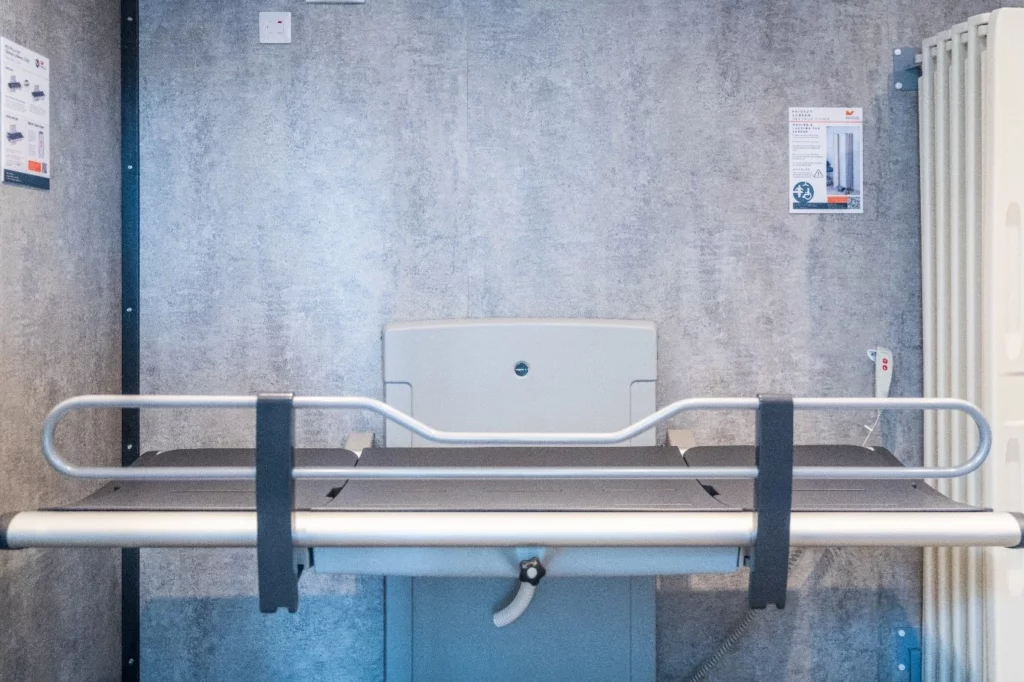
Fixed height-adjustable changing bench inside a Changing Places toilet.
Here are some examples of how each piece of specialist equipment helps to make everyday life easier for disabled people and their carers whilst out in public:
- Space: Having a minimum floor space of 12sqm ensures there is enough room for a disabled person when they are not in their wheelchair, their wheelchair, and up to two carers to comfortably use the facilities. The 2.4m minimum ceiling height ensures the hoist system can be used safely for lifting.
- Doorways: Individuals with profound disabilities typically require an electric wheelchair or powerchair because they cannot push themselves in a manual wheelchair. Many of these electric wheelchairs will be wider than the 900mm doorways included on standard accessible toilets. Providing a doorway with a 1000mm minimum width accommodates larger wheelchairs.
- Toilets: Including a peninsular toilet with 1m space either side ensures there is enough room for carers to assist on either/both sides. The 480mm toilet seat height facilitates easier, more comfortable transfers from wheelchair to toilet.
- Basins: A height-adjustable basin provides flexibility for multi-user environments. Users of different heights, or with different size wheelchairs can use the facilities as they require.
- Hoists: A hoist with full room coverage allows a disabled person to be transferred from their wheelchair to the toilet or changing bench and back to their chair safely and easily. It also makes changing and toileting easier on carers as no manual handling is required.
- Changing Benches: When a changing bench is not present, disabled adults who require changing are forced to lie on the floor. This is unhygienic, undignified and unsafe for both the individual and their carer. A changing bench provides a clean and appropriate area for changing.
- Sanitary Bins: Including a larger sanitary bin helps to keep the Changing Places toilet clean and hygienic for all users. With a standard sanitary bin, there is a risk that they would not be emptied often enough to keep up with frequent use.
Summary
What is Changing Places toilet. By reading our guide, you will have learnt that Changing Places are more than a standard accessible toilet, providing specialist equipment that meets the needs of individuals with complex disabilities who cannot use the toilet independently.
Most significantly, Changing Places provide hoists and changing benches for people who cannot stand to get onto the toilet or who use continence products.
This creates an inclusive environment which disabled people and their carers can use to meet their personal care needs — something which should be a basic right for everyone whilst out in public! In places which only have standard accessible toilets, these individuals are faced with the unacceptable options of changing on an unhygienic toilet floor or staying home.
To be truly inclusive of disabled visitors and their families, all large public places should invest in Changing Places toilets. Cinemas, museums, shopping centres, bus and train stations and libraries are all examples of places disabled people and their relatives may be forced to avoid due to lack of appropriate facilities.
Help make your venue more accessible by using the contact form below to book a Changing Places consultation with one of our experts.
Can we help with anything?
Be sure to use the contact form and reach out to us if you have any questions about the content above.